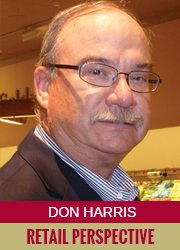 During conversations on sustainability in the boardroom, the topic of donating out-of-date, or over-ordered, or unsalable merchandise is often discussed. Management also looks at this as an opportunity to gain some publicity by demonstrating their environmentally friendly policies to the public. Executives view it as a chance to promote and enhance the reputation of the company as one that cares about the environment. The reasons for this way of thinking are far more complicated than that, and once again it shows that management “just doesn’t get it!”
During conversations on sustainability in the boardroom, the topic of donating out-of-date, or over-ordered, or unsalable merchandise is often discussed. Management also looks at this as an opportunity to gain some publicity by demonstrating their environmentally friendly policies to the public. Executives view it as a chance to promote and enhance the reputation of the company as one that cares about the environment. The reasons for this way of thinking are far more complicated than that, and once again it shows that management “just doesn’t get it!”
For most retailers, donations of unneeded or past salable product often requires local food banks to pick up the product at the store and take it back to the food bank. This is one of the largest sources of still-usable food and produce obtained by food banks. It also benefits the retailers as it provides the removal of unsalable merchandise at no cost. The key to making this program successful is the ability to provide products, especially produce, with available life so that the food bank can utilize it in its feeding programs.
This program presents a problem for the retail produce department, however, as it has already paid for the product from the warehouse and received no credit for the donation. The donation is basically recorded and benefits the company through a tax deduction. The challenge with this scenario is that without receiving credit, the produce department tries as long as possible to sell the product before donating it, as the donation counts against the department as shrink loss. The solution to this problem would be to credit the department with the donation. This would likely prove difficult as management would view it is a way to subsidize sub-par purchasing.
A second and potentially more important method for the elimination of waste caused by too much inventory is the ability to donate to food banks and other organizations directly from the warehouse.
A second and potentially more important method for the elimination of waste caused by too much inventory is the ability to donate to food banks and other organizations directly from the warehouse. This would solve the problem of oversupply or over-ordering where the inventory in the warehouse exceeds the demand from stores. By donating this excess inventory to one of the organizations, it prevents the overburdening of the stores with too much product. The result of this type of “plus out” is a negative effect on inventory turns, labor required to display, impact on overall quality of distressed merchandise and additional disposal problems in the store. These negatives are neatly checked by donations that are made direct from the warehouse. It also benefits the warehouse as it increases inventory turns and maintains the integrity and quality of the product being shipped. The non-profit organizations accepting produce donations appreciate this remedy as it provides perishables that have more shelf life, which allows for greater flexibility.
Another benefit of this warehouse program for the retailer is the identification of inefficiencies in the ordering processes and procedures for produce and other commodities. By recording and tracking the donations, retailers can determine where the problems lie in terms of procurement. Subsequently, they can initiate policies to shore up the ordering procedures and thus eliminate “product loss” at the warehouse, and ultimately at the store. As a result, the ordering becomes more efficient and the cost of loss is avoided, providing the benefits of increased inventory turns, maintenance of quality and more efficient use of warehouse space. Unfortunately, this process will reduce the amount of donations to these various charitable institutions because the benefits of improved procurement procedures and elimination of lost inventory costs make more practical business sense for the company.
It may seem that the second action would be counterproductive to the overall purpose of donations and reduction of waste. However, it represents a more practical way, and a profitable one, to improve your operation while reducing your waste stream. It represents an opportunity for retailers to increase the efficiency of their operation, reduce costs and contribute to the reduction of waste from the operation. It would be a win-win situation, as it would improve overall profitability and make dividend reductions in the waste stream.
Don Harris is a 43-year veteran of the produce industry, with most of that time spent in retail. He worked in every aspect of the industry, from “field-to-fork” in both the conventional and organic arenas. Harris is presently consulting and is director of produce for the Chicago-based food charity organization, Feeding America. Comments can be directed to [email protected].




